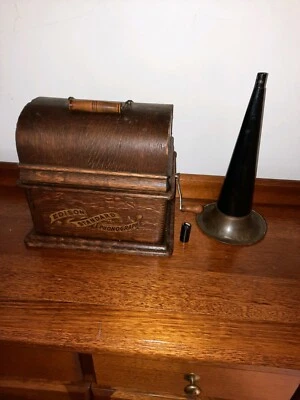Edison Phonograph Serial Number List
- Edison Phonograph Serial Number List Pdf
- Edison Phonograph Serial Number Listing
- Edison Phonograph Serial Number Lookup


Edison Phonograph Serial Number List Pdf
Edison Phonograph Serial Number Listing
Photograph of Thomas A. Edison listening to the New Edison Diamond Disc Phonograph. Advertisement in The Gramophone, December 1923. Cylinders peaked in popularity around 1905. After this, discs and disc players, most notably the Victrolas, began to dominate the market. Columbia Records, an Edison competitor, had stopped marketing cylinders in 1912. An Edison Standard Phonograph model H in oak case serial number 660140, 35 x 34 x 25 cm Show 11 more like this Sold by in for You can display prices in $Au, $US, $NZ or Stg.
Edison Phonograph Serial Number Lookup
Edison Cylinder phonographs were the dominant cylinder phonographs all around the world from 1877 when Edison first invented the phonograph until 1929 when demand for cylinder phonographs had all but faded, and the last cylinder machine was made.
Edison machine were extremely well made and any machine that has survived the last century will probably be playing as well today as when it left the factory.
Models of sizes and models are numerous; Gem, Standard, Home, Fireside, Triumph & Idelia, playing standard size cylinders. Initially 2 minute wax cylinders, and as the models progressed, also 4 minute Amberol cylinders (needing a different stylus and feedscrew gearing. These models could be equipped with a variety of horns.
The Concert phonographs playing the large Concert size cylinders. The Opera phonograph was made for 4 minute cylinders and where the mandrel traversed under a fixed reproducer.
And of course an array of early electric phonographs, as well as phonographs set up to be operated by money for operation in bars and public places.
Later Edison phonographs, from around 1912 to 1929 were called 'Amberola', and were phonographs contained within tabletop or floor standing cabinets. To access the phonograph you had to open a lid. Benefit of the lid was that it dampened playing noise, leaving only the pure music eminating from the enclosed horn.
The Edison Phonograph models have been very well researched and we would like to recognise those efforts by referring you to these books on the subject, as they completely and precisely detail each make and model.
Edison machine were extremely well made and any machine that has survived the last century will probably be playing as well today as when it left the factory.
Models of sizes and models are numerous; Gem, Standard, Home, Fireside, Triumph & Idelia, playing standard size cylinders. Initially 2 minute wax cylinders, and as the models progressed, also 4 minute Amberol cylinders (needing a different stylus and feedscrew gearing. These models could be equipped with a variety of horns.
The Concert phonographs playing the large Concert size cylinders. The Opera phonograph was made for 4 minute cylinders and where the mandrel traversed under a fixed reproducer.
And of course an array of early electric phonographs, as well as phonographs set up to be operated by money for operation in bars and public places.
Later Edison phonographs, from around 1912 to 1929 were called 'Amberola', and were phonographs contained within tabletop or floor standing cabinets. To access the phonograph you had to open a lid. Benefit of the lid was that it dampened playing noise, leaving only the pure music eminating from the enclosed horn.
The Edison Phonograph models have been very well researched and we would like to recognise those efforts by referring you to these books on the subject, as they completely and precisely detail each make and model.